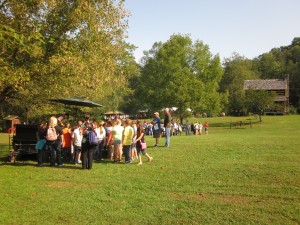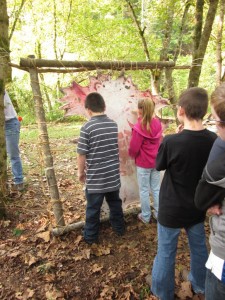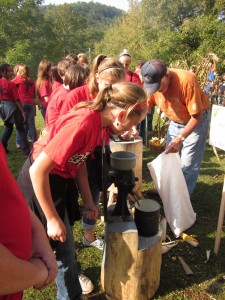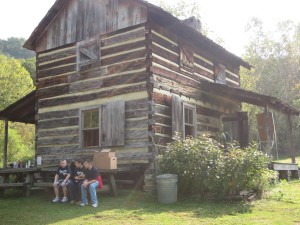
Welcome to Living Archaeology Weekend in Kentucky! On the third weekend of September, every year, over 1500 people travel to the Gladie Learning Center in the Red River Gorge in Kentucky, to learn about technologies through time. The objective of Living Archaeology Weekend (LAW) is to provide a diverse, high-quality, multi-sensory educational opportunity in American Indian and Pioneer technologies and other lifeways, archaeological interpretation, and archaeological site preservation.
The Audience
Each year, the Friday of LAW is devoted to a target audience of over 800 5th graders from local and regional schools. In recent years, the steering committee developed teacher training workshops, pre-field trip classroom visits, and formal curriculum that can be used throughout the year. After their visit, students have the opportunity to enter an essay contest addressing the importance of preservation of cultural resources. The winning student receives accolades in the news, and pizza party for their class, and a set of classroom resources for their teacher.
On Saturday, LAW is open to the public and typically draws upwards of 900-1000 visitors. On both days, the demonstrations are held on the rolling acreage of the Gladie Learning Center. The native technology and lifeways demonstrations are set-up along a creek floodplain, and the pioneer technology and lifeways demonstrations are located at the Gladie Cabin.
The Experience
 The Native Demonstration Area hosts a number of exciting technology demonstrations, including flintknapping, bow-arrow, fishing, blowguns, pottery making, stone bowl and pipe making, willow basket weaving, and cane mat weaving. Visitors can try their hand at spear throwing with an atlatl, cattail mat weaving, cordage making, and hide tanning. At the pump drill demonstration, visitors use flint-tipped drills to make their own shell and rock pendants.
The Native Demonstration Area hosts a number of exciting technology demonstrations, including flintknapping, bow-arrow, fishing, blowguns, pottery making, stone bowl and pipe making, willow basket weaving, and cane mat weaving. Visitors can try their hand at spear throwing with an atlatl, cattail mat weaving, cordage making, and hide tanning. At the pump drill demonstration, visitors use flint-tipped drills to make their own shell and rock pendants.
At the plant domestication demonstration, visitors learn about native crops, use native gardening technologies like digging sticks and shell hoes, and earn free packets of native squash seeds. Because the Red River Gorge is a World Hearth of Plant domestication, we have a demonstration on medicinal plant use on Friday. Learning about plants that were first domesticated in Kentucky, and how those plants were used for food, shelter, storage, and clothing is just one of the many experiences at LAW.
Other demonstrations focus on native arts and games. Visitors learn about cane flutes and listen to beautiful music. On Friday, members of the United Keetoowah Band of Cherokee Indians of Oklahoma lead students in the traditional stickball game. On Saturday, they demonstrate the Cherokee marble game and basket making.

Several of the pioneer demonstrations focus on corn, from farming and processing methods to tools and technology to crafts. At the spinning and quilting demonstrations, visitors can use drop spindles and tack a quilt. Students participating in Living Archaeology Weekend 2011 helped create a beautiful quilt for Community Hospice in Ashland, Kentucky. The blacksmith demonstrates methods of forging, melding, heat treating, and finishing. A longhunter recreator in period dress describes technology and trading on the early Kentucky frontier. Music demonstrations featuring traditional instruments celebrate the rich traditions of Appalachia.
The Gladie cabin, which was listed on the National Register of Historic Places in 1989, formerly served as a hotel, a post office, and a home before being moved to the Gladie Cultural-Environmental Learning Center. Stewardship and preservation are also a primary goal of the event, and visitors are invited to tour the Gladie Cabin and learn about the importance of site stewardship. This particular cabin has been furnished over time with collected materials from the community. Rather than interpret a particular period in the cabin, or take out modern materials, we decided to harness the teachable moment and, next year, ask the visitors to think critically about the cabin and to decide what items might not represent the cabin history accurately. Do you have ideas on more ways to interpret historic cabins?
Growing and improving

The steering committee is always brain storming ways to improve our materials and the experience. One oversight we recognized this year was that the connection between archaeology and the demonstrated technologies is not clear. One solution is to develop signage for each station noting clear, concise examples of archaeological signatures for each technology. We’d appreciate examples or suggestions below!
In addition to improving the actual event, we are constantly seeking new ways to attract educators in our region to the teacher workshop. If you have suggestions on reaching teachers and successfully attracting them to a certified training event, please let us know.
Support
LAW is made possible by a host of private sponsors and, in large part, by the Daniel Boone National Forest, the Kentucky Archaeology Survey, the Kentucky Organization of Professional Archaeologists, and the Kentucky Heritage Council. This year marked the 24th year of the event and we are proud to say that it gets better every year! Check out our website for more event details and links to education materials (www.livingarchaeologyweekend.org ).

